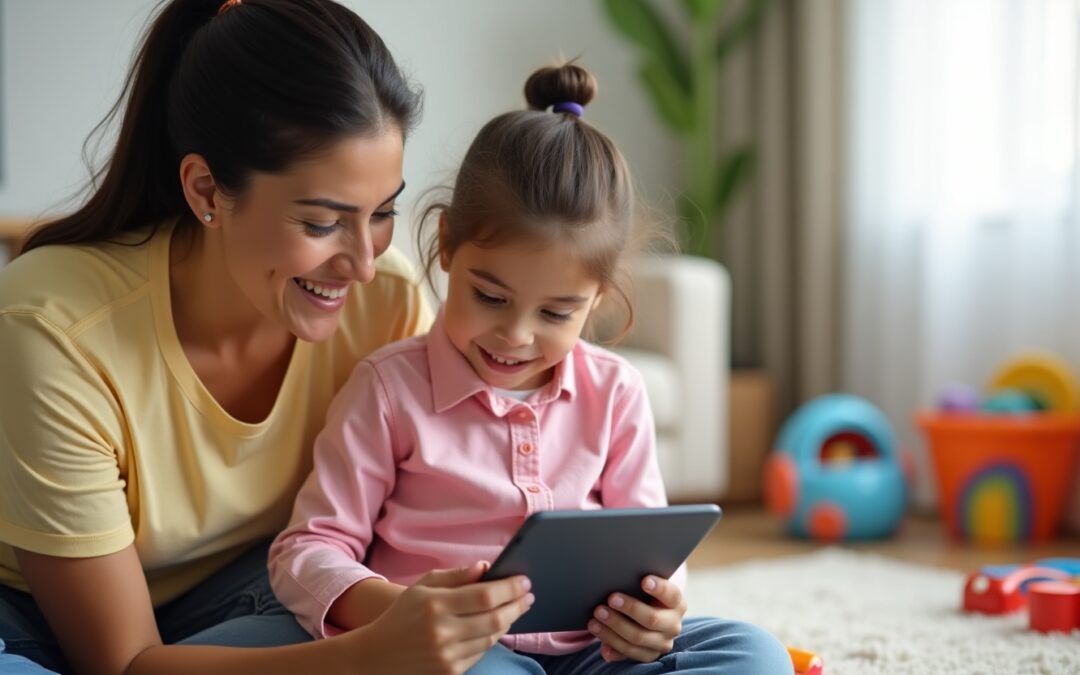Screens are everywhere, from digital whiteboards in classrooms to tablets at the dinner table. In today’s connected world, it’s nearly impossible to raise children without technology playing a role. But as much as screens can educate and entertain, they also raise tough questions for parents and nannies alike: How much is too much? What’s healthy? And how can we teach kids to use technology mindfully rather than mindlessly?
Finding the right balance with screen time for kids isn’t about cutting technology out entirely. It’s about creating boundaries that support healthy development. With thoughtful planning, collaboration, and consistency, caregivers can use screens as tools for growth, not distractions.
1) Why Screen Time Matters
According to the American Academy of Pediatrics (AAP), screen time affects everything from sleep and attention span to language development and emotional health. While interactive, age-appropriate media can promote learning, excessive or unsupervised use can disrupt real-world connection, creativity, and physical play, all essential for developing minds.
The goal isn’t to fear screen time for kids, but to guide children toward using them intentionally. When adults model mindful tech habits and provide structure, screens become a supplement to play and learning, not a replacement for them.
2) Current Screen Time Recommendations
Per the AAP’s Media Guidelines and World Health Organization (WHO) recommendations:
- Under 18 months: Avoid screen time, except for occasional video chats with family.
- Ages 18–24 months: Introduce limited, high-quality content (like PBS Kids or Sesame Workshop) and always co-view with an adult.
- Ages 2–5 years: Limit to 1 hour per day of high-quality programming, ideally split into shorter sessions.
- Ages 6 and up: Set consistent limits that ensure screen use doesn’t interfere with sleep, physical activity, homework, or in-person relationships.
What matters most isn’t just how much time kids spend on screens, but how and why they use them.
3) Understanding the Pros and Cons of Screen Time for Kids
a) The Benefits:
- Educational value – Interactive apps and videos can reinforce literacy, numeracy, and problem-solving.
- Connection – Video calls keep children close to long-distance relatives and friends.
- Creativity and self-expression – Platforms that allow drawing, coding, or storytelling can enhance innovation.
b) The Risks:
- Overstimulation and poor sleep – Blue light exposure and rapid visual input can interfere with rest.
- Delayed communication skills – Too much passive screen time can limit face-to-face conversation.
- Behavioral challenges – Research links excessive screen use to shorter attention spans and frustration tolerance issues.
Balanced screen habits allow kids to enjoy the benefits of technology while minimizing potential downsides.
4) Practical Strategies for Finding Balance
a) Create a Family (or Nanny-Family) Media Plan
Sit down together and decide:
- When screens can be used (e.g., after homework, weekends only).
- Where screens are allowed (e.g., not during meals or in bedrooms).
- What kind of content is acceptable (educational vs. entertainment).
The AAP even offers a customizable Family Media Plan to help guide these decisions.
b) Model Healthy Tech Habits
Children learn more from what they see than what they’re told. If adults constantly scroll during playtime or meals, kids pick up that behavior. Modeling moderation, putting phones away during quality time, teaches balance and presence.
c) Prioritize Screen-Free Moments
Set up “tech-free zones” or “unplugged hours” each day. For example:
- No screens at meals to encourage conversation.
- No screens one hour before bedtime to support better sleep.
- Outdoor play first, screens later. Physical activity promotes self-regulation and focus.
d) Co-View and Engage
When watching or using apps with children, ask questions and talk about what they’re seeing. For example:
- “Why do you think that character felt sad?”
- “Can you show me how you solved that puzzle?”
This turns passive viewing into an opportunity for emotional and cognitive development.
e) Teach Digital Literacy Early
For school-aged children, screen time isn’t just entertainment. It’s a gateway to communication and identity. Use media time to teach:
- How to recognize credible sources online.
- The importance of kindness and safety in digital interactions.
- Setting boundaries around privacy and sharing.
This helps children build confidence and responsibility as digital citizens.
5) How Nannies and Parents Can Work Together
Consistency is key. Children thrive when caregivers are on the same page about expectations. Discuss:
- Screen time limits and routines.
- Approved shows, apps, or games.
- How to handle “meltdowns” when screen time ends.
Share feedback often. If a child struggles with transitions, collaborate on new strategies (like timers, countdowns, or activity swaps).
Screens are part of modern life, and when used thoughtfully, they can be powerful learning tools. The key is balance: ensuring technology enhances your child’s world instead of replacing it.
By setting clear expectations, modeling healthy behavior, and encouraging active engagement, nannies and parents can help children grow up tech-savvy, mindful, and emotionally grounded, ready to thrive both on and off the screen.


Recent Comments